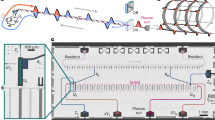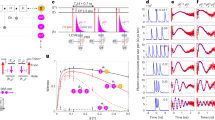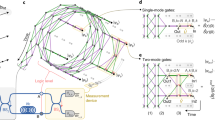Abstract
Measurement-based quantum computing is a promising paradigm of quantum computation, in which universal computing is achieved through a sequence of local measurements. The backbone of this approach is the preparation of multipartite entanglement, known as cluster states. Although a cluster state with two-dimensional connectivity is required for universality, a three-dimensional cluster state is necessary for additionally achieving fault tolerance. However, the challenge of making three-dimensional connectivity has limited cluster state generation capability up to two dimensions. Here we demonstrate the deterministic generation of a three-dimensional cluster state based on the photonic continuous-variable platform. To realize three-dimensional connectivity, we harness a crucial advantage of time–frequency modes of ultrafast quantum light: an arbitrary complex mode basis can be accessed directly, enabling connectivity as desired. We demonstrate the versatility of our method by generating cluster states with one-, two- and three-dimensional connectivities. For their complete characterization, we develop a quantum state tomography method for multimode Gaussian states. Moreover, we verify the cluster state generation by nullifier measurements as well as full inseparability tests. Our work paves the way towards fault-tolerant and universal-measurement-based quantum computing.
This is a preview of subscription content, access via your institution
Access options
Access Nature and 54 other Nature Portfolio journals
Get Nature+, our best-value online-access subscription
$32.99 / 30 days
cancel any time
Subscribe to this journal
Receive 12 print issues and online access
$259.00 per year
only $21.58 per issue
Buy this article
- Purchase on SpringerLink
- Instant access to full article PDF
Prices may be subject to local taxes which are calculated during checkout




Similar content being viewed by others
Data availability
The data that support the findings of this study are available from the corresponding author upon reasonable request.
Code availability
The code used to produce the results are available from the corresponding author upon reasonable request.
References
Bourassa, J. E. et al. Blueprint for a scalable photonic fault-tolerant quantum computer. Quantum 5, 392 (2021).
Yokoyama, S. et al. Ultra-large-scale continuous-variable cluster states multiplexed in the time domain. Nat. Photon. 7, 982–986 (2013).
Chen, M., Menicucci, N. C. & Pfister, O. Experimental realization of multipartite entanglement of 60 modes of a quantum optical frequency comb. Phys. Rev. Lett. 112, 120505 (2014).
Larsen, M. V., Guo, X., Breum, C. R., Neergaard-Nielsen, J. S. & Andersen, U. L. Deterministic generation of a two-dimensional cluster state. Science 366, 369–372 (2019).
Asavanant, W. et al. Generation of time-domain-multiplexed two-dimensional cluster state. Science 366, 373–376 (2019).
Hamilton, C. S. et al. Gaussian boson sampling. Phys. Rev. Lett. 119, 170501 (2017).
Deshpande, A. et al. Quantum computational advantage via high-dimensional Gaussian boson sampling. Sci. Adv. 8, eabi7894 (2022).
Zhong, H.-S. et al. Quantum computational advantage using photons. Science 370, 1460–1463 (2020).
Madsen, L. S. et al. Quantum computational advantage with a programmable photonic processor. Nature 606, 75–81 (2022).
Aaronson, S. & Arkhipov, A. The computational complexity of linear optics. In Proc. Forty-Third Annual ACM Symposium on Theory of Computing 143–252 (Association for Computing Machinery, 2013).
Raussendorf, R. & Briegel, H. J. A one-way quantum computer. Phys. Rev. Lett. 86, 5188–5191 (2001).
Menicucci, N. C. et al. Universal quantum computation with continuous-variable cluster states. Phys. Rev. Lett. 97, 110501 (2006).
van Loock, P., Weedbrook, C. & Gu, M. Building Gaussian cluster states by linear optics. Phys. Rev. A 76, 032321 (2007).
Menicucci, N. C., Flammia, S. T. & van Loock, P. Graphical calculus for Gaussian pure states. Phys. Rev. A 83, 042335 (2011).
Enomoto, Y., Yonezu, K., Mitsuhashi, Y., Takase, K. & Takeda, S. Programmable and sequential Gaussian gates in a loop-based single-mode photonic quantum processor. Sci. Adv. 7, eabj6624 (2021).
Larsen, M. V., Guo, X., Breum, C. R., Neergaard-Nielsen, J. S. & Andersen, U. L. Deterministic multi-mode gates on a scalable photonic quantum computing platform. Nat. Phys. 17, 1018–1023 (2021).
Raussendorf, R., Harington, J. & Goyal, K. A fault-tolerant one-way quantum computer. Ann. Phys. 321, 2242–2270 (2006).
Raussendorf, R., Harrington, J. & Goyal, K. Topological fault-tolerance in cluster state quantum computation. New J. Phys. 9, 199 (2007).
Kitaev, A. Fault-tolerant one-way quantum computer. Ann. Phys. 303, 2242–2270 (2006).
Fowler, A. G., Mariantoni, M., Martinis, J. M. & Cleland, A. N. Surface code: towards parctical large-scale quantum computation. Phys. Rev. A 86, 032324 (2012).
Bolt, A., Duclos-Cianci, G., Poulin, D. & Stace, T. M. Foliated quantum error-correcting codes. Phys. Rev. Lett 117, 070501 (2016).
Zhang, J., Xie, C., Peng, K. & van Loock, P. Anyon statistics with continuous variables. Phys. Rev. A 78, 052121 (2008).
Aoki, T. et al. Quantum error correction beyond qubits. Nat. Phys. 5, 541–546 (2009).
van Loock, P. A note on quantum error correction with continuous variables. J. Mod. Opt. 57, 1965–1971 (2010).
Gottesman, D., Kitaev, A. & Preskill, J. Encoding a qubit in an oscillator. Phys. Rev. A 64, 012310 (2001).
Fukui, K., Tomita, A., Okamoto, A. & Fujii, K. High-threshold fault-tolerant quantum computation with analog quantum error correction. Phys. Rev. X 8, 021054 (2018).
Fukui, K., Asavanant, W. & Furusawa, A. Temporal-mode continuous-variable three-dimensioinal cluster state for topologically protected measurement-based quantum computation. Phys. Rev. A 102, 032614 (2020).
Larsen, M. V., Chamberland, C., Noh, K., Neergaard-Nielsen, J. S. & Andersen, U. L. Fault-tolerant continuous-variable measurement-based quantum computation architecture. PRX Quantum 2, 030325 (2021).
Wu, B. H., Alexander, R. N., Liu, S. & Zhang, Z. Quantum computing with multidimensional continuous-variable cluster states in a scalable photonic platform. Phys. Rev. Res. 2, 023138 (2020).
Du, P., Wang, Y., Liu, K., Yang, R. & Zhang, J. Generation of large-scale continuous-variable cluster states multiplexed both in time and frequency domains. Opt. Express 31, 7535–7544 (2023).
Roslund, J., Araújo, R. M., Jiang, S., Fabre, C. & Treps, N. Wavelength-multiplexed quantum networks with ultrafast frequency combs. Nat. Photon. 8, 109–112 (2014).
Roman-Rodriguez, V. et al. Multimode squeezed state for reconfigurable quantum networks at telecommunication wavelengths. Phys. Rev. Res. 6, 043113 (2024).
Roh, C., Yoon, Y.-D., Park, J. & Ra, Y.-S. Continuous-variable nonclassicality certification under coarse-grained measurement. Phys. Rev. Res. 5, 043057 (2023).
Cai, Y. et al. Multimode entanglement in reconfigurable graph states using optical frequency combs. Nat. Commun. 8, 15645 (2017).
Ansari, V., Donohue, J. M., Brecht, B. & Silberhorn, C. Tailoring nonlinear processes for quantum optics with pulsed temporal-mode encodings. Optica 5, 534–550 (2018).
Ra, Y.-S. et al. Non-Gaussian quantum states of a multimode light field. Nat. Phys. 16, 114–147 (2020).
Sørensen, A. S. & Mølmer, K. Entanglement and extreme spin squeezing. Phys. Rev. Lett. 86, 4431–4434 (2001).
Sośnicki, F., Mikołajczyk, M., Golestani, A. & Karpiński, M. Interface between picosecond and nanosecond quantum light pulses. Nat. Photon. 17, 761–766 (2023).
Serino, L. et al. Realization of a multi-output quantum pulse gate for deconding high-dimensional temporal modes of single-photon states. PRX Quantum 4, 020306 (2023).
Duan, L.-M., Giedke, G., Cirac, J. I. & Zoller, P. Inseparability criterion for continuous variable systems. Phys. Rev. Lett. 84, 2722–2725 (2000).
Bowen, W. P., Schnabel, R., Lam, P. K. & Ralph, T. C. Experimental investigation of criteria for continuous variable entanglement. Phys. Rev. Lett. 90, 043601 (2003).
Patera, G., Treps, N., Fabre, C. & De Valcárcel, G. J. Quantum theory of synchronously pumped type I optical parametric oscillators: characterization of the squeezed supermodes. Eur. Phys. J. D 56, 123–140 (2009).
Braunstein, S. L. Squeezing as an irreducible resource. Phys. Rev. A 71, 055801 (2005).
van Loock, P. & Furusawa, A. Detecting genuine multipartite continuous-variable entanglement. Phys. Rev. A 67, 052315 (2003).
Simon, R. Peres-Horodecki separability criterion for continuous variable systems. Phys. Rev. Lett. 84, 2726–2729 (2000).
Wiseman, H., Jones, S. & Doherty, A. Steering, entanglement, nonlocality, and the Einstein-Podolsky-Rosen paradox. Phys. Rev. Lett. 98, 140402 (2007).
Kim, H.-J., Jung, J.-H., Lee, K.-J. & Ra, Y.-S. Recovering quantum entanglement after its certification. Sci. Adv. 9, eadi5261 (2023).
Kogias, I., Lee, A. R., Ragy, S. & Adesso, G. Quantification of Gaussian quantum steering. Phys. Rev. Lett. 114, 060403 (2015).
González-Arciniegas, C., Nussenzveig, P., Martinelli, M. & Pfister, O. Cluster states from Gaussian states: essential diagnotic tools for continuous-variable one-way quantum computing. PRX Quantum 2, 030343 (2021).
Eisert, J., Scheel, S. & Plenio, M. B. Distilling Gaussian states with Gaussian operations is impossible. Phys. Rev. Lett. 89, 137903 (2002).
Miwa, Y. et al. Demonstration of cluster-state shaping and quantum erasure for continuous variables. Phys. Rev. A 82, 032305 (2010).
Clements, W. R., Humphreys, P. C., Metcalf, B. J., Kolthammer, W. S. & Walsmley, I. A. Optimal design for universal multiport interferometers. Optica 3, 1460–1465 (2016).
Presutti, F. et al. Highly multimode visible squeezed light with programmable spectral correlations through broadband up-conversion. Preprint at https://arxiv.org/abs/2401.06119 (2024).
Menicucci, N. C. Fault-tolerant measurement-based quantum computing with continuous-variable cluster states. Phys. Rev. Lett. 112, 120504 (2014).
Acknowledgements
We thank M. S. Kim and J. Park for fruitful discussions. This work was supported by the Ministry of Science and ICT (MSIT) of Korea (NRF-2020M3E4A1080028, NRF-2022R1A2C2006179 and RS-2023-NR119925) under the Information Technology Research Center (ITRC) support program (IITP-2025-2020-0-01606) and the Institute of Information & Communications Technology Planning & Evaluation (IITP) grant (no. 2022-0-01029, Atomic ensemble based quantum memory) and by the Air Force Office of Scientific Research award (nos. FA2386-21-1-4020 and FA2386-22-1-4083).
Author information
Authors and Affiliations
Contributions
C.R. conducted the experiment with contributions from G.G. and Y.-D.Y. C.R. analysed the data and developed the theory. Y.-S.R. conceived and supervised the project. C.R. and Y.-S.R. wrote the manuscript with inputs from all authors.
Corresponding author
Ethics declarations
Competing interests
The authors declare no competing interests.
Peer review
Peer review information
Nature Photonics thanks Jiangrui Gao and the other, anonymous, reviewer(s) for their contribution to the peer review of this work.
Additional information
Publisher’s note Springer Nature remains neutral with regard to jurisdictional claims in published maps and institutional affiliations.
Extended data
Extended Data Fig. 1 Ancilla-assisted generation of a cluster state with negative weights.
The same method as Fig. 4 is used to generate a 3D cluster state with negative weights. a, Four edges (6-7, 6-13, 9-10, and 10-11) in Gbasic have negative weights. b, Experimentally generated 3D cluster state after local phase correction in the range of (− 0.18, 0.18) rad. c, Nullifier measurements on the generated 3D cluster state. d, Conditional covariance matrix in the target modes. e, Inseparability test for the cluster state in (d), exhibiting negative minimum eigenvalues for all bipartitions. f, Nullifier variances of the target cluster state after removing the ancilla. In c and f, data are presented as scatter plots (from four repeated experiments), with mean values as bar charts and ± 1 s.d. as error bars.
Supplementary information
Supplementary Information
Supplementary Figs. 1–5, Sections 1–4 and References.
Rights and permissions
Springer Nature or its licensor (e.g. a society or other partner) holds exclusive rights to this article under a publishing agreement with the author(s) or other rightsholder(s); author self-archiving of the accepted manuscript version of this article is solely governed by the terms of such publishing agreement and applicable law.
About this article
Cite this article
Roh, C., Gwak, G., Yoon, YD. et al. Generation of three-dimensional cluster entangled state. Nat. Photon. 19, 526–532 (2025). https://doi.org/10.1038/s41566-025-01631-2
Received:
Accepted:
Published:
Issue date:
DOI: https://doi.org/10.1038/s41566-025-01631-2
This article is cited by
-
Quantum cluster states engineered in three dimensions
Nature Photonics (2025)
-
Deterministic generation of two-dimensional multi-photon cluster states
Nature Communications (2025)



